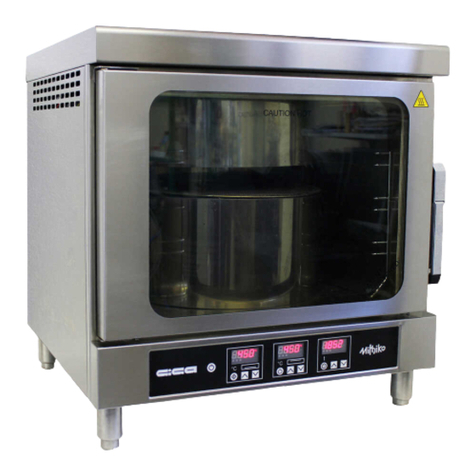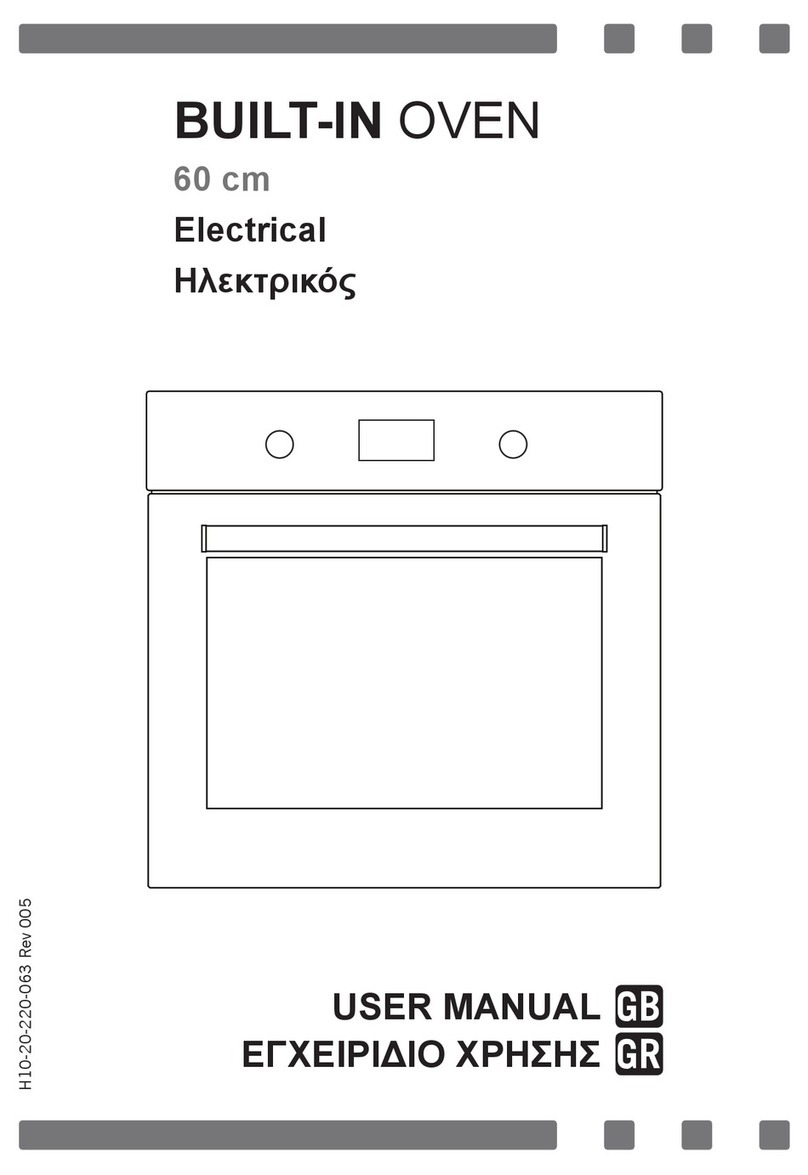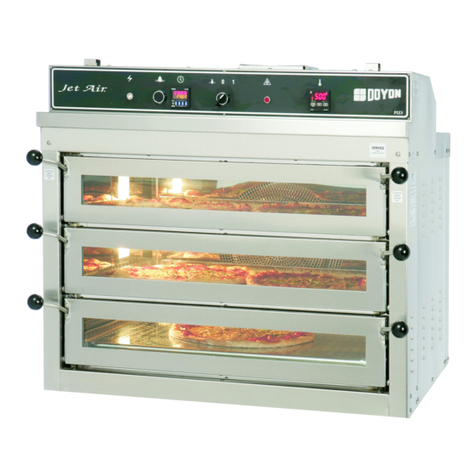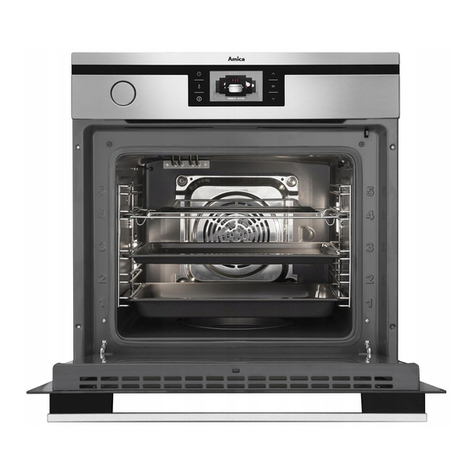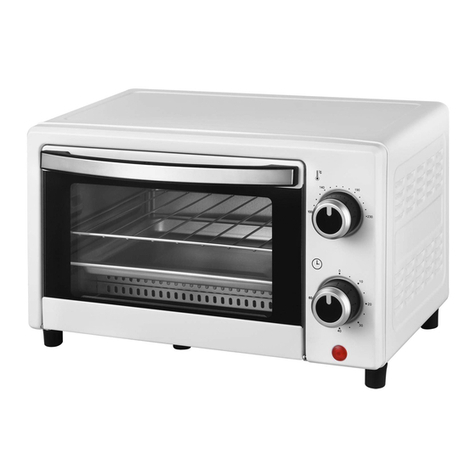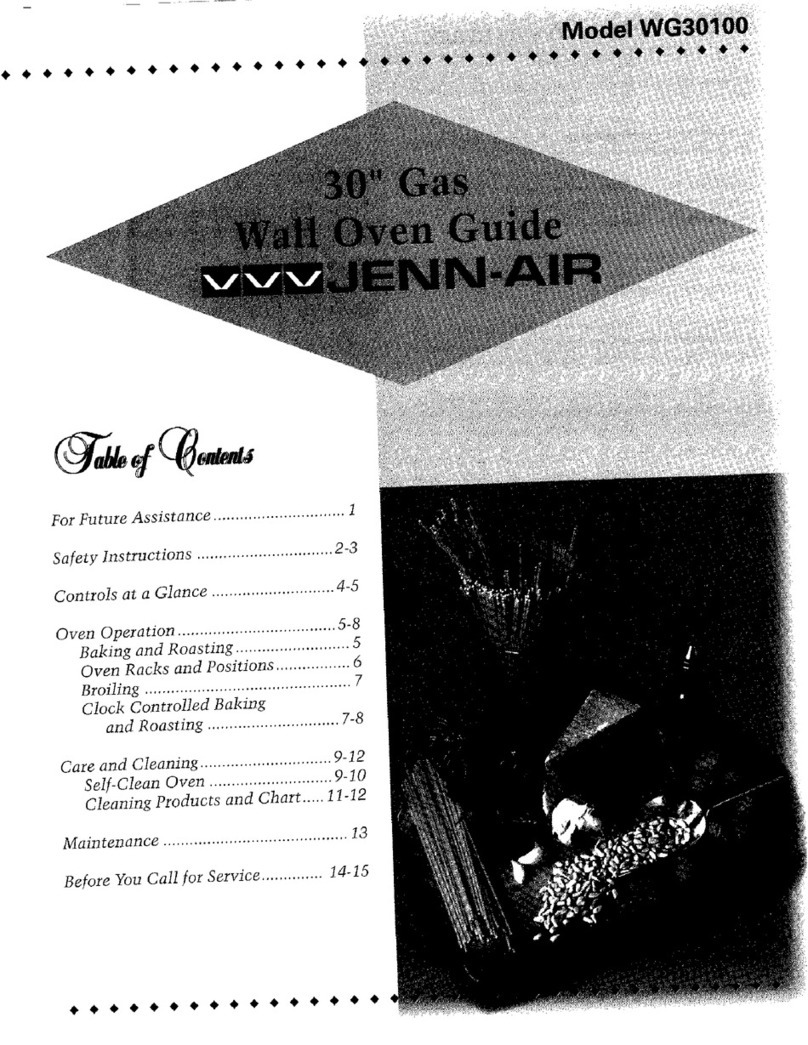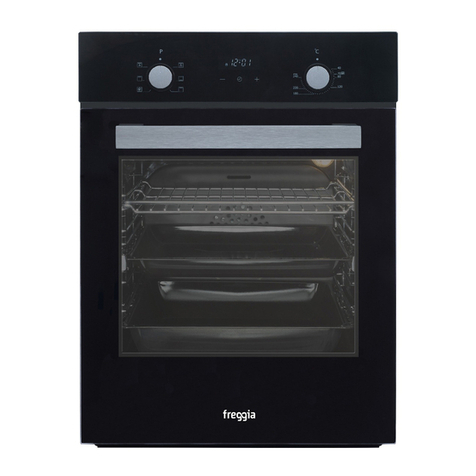GIGA GSP01 Quick start guide

0877_GB_99
02/2008
Instructions for installation,
use e maintenance
ELECTRIC OVEN
GSP01

CHARACTERISTICS
0877_GB_99 - ELECTRIC OVEN
2· 16
02/2008
Supplied by:
Date:
Customer Service:
FAX
e-mail

0877_GB_99 - ELECTRIC OVEN
3· 16
02/2008
INDEX
1 Diagram 4
2 Features of the appliances 5
3 Technical data 5
4 Installation instructions 6
4.1 Safety rules 6
4.2 Structure, framework and safety 6
4.3 Assembly 6
4.3.1 Installation premises 6
4.3.2 Statutory regulations and technical requirements 6
4.3.3 Installation 7
4.3.4 Positioning 7
4.3.5 Electrical connection and equipotential bonding 7
5 Operation preparation 7
5.1 Preparation and Start-up 7
5.1.1 Start-up 7
5.2 Maintenance 7
6 Instructions for use 8
6.1 Safety, cleaning and repair rules 8
6.2 Start-up and shutting down 8
6.2.1 Setting and using the timer 8
6.2.2 Setting the temperature 8
6.2.3 Interior light 9
6.3 Cooking 9
6.4 Appliance care and frequency of maintenance 9
6.4.1 Precautions in the event of a malfunction 9
6.4.2 Precautions if not using for long periods 9
6.5 Cleaning and taking care of the machine 9
6.5.1 WEEE Directive 9
7 Reserved for technical support 11
Wiring diagram 11
Service connections 11
Thermocouple connections 11
Power connections 12
7.1 Test mode and thermocouple configuration 12
7.1.1 Auto-test and setting the thermocouple type 12
7.2 Temperature display 12
7.3 Replacement of spare parts 12

0877_GB_99 - ELECTRIC OVEN
4· 16
02/2008
52 444
607.5
95 551
31 538 31
50 600
95 551
600
547.5
60
50 94 46937
444 52
31 538 31
60
Equipotential
Data plate
P
Open
1 - DIAGRAM

0877_GB_99 - ELECTRIC OVEN
5· 16
02/2008
2 - CHARACTERISTICS OF THE APPLIANCES
3 - TECHNICAL DATA
These appliances are used for professional purposes.
Installation, repair and use must be carried out by expert personnel.
The data plate is placed near the power cable input and provides all
the information necessary for electrical connection.
Beware of inexpert handling.
Model
GSP01
Dimensions in mm. (WxDxH)
650x620x646 230 V / 12,76 A 2,934 kW
3 x 2.5 mm2
Power Lead wire sectionVoltage rating / Absorption
TIPO/TYPE
CAT/KAT GAS/GAZ G30 G31 G20 G25
II2H3B/P P mbar 30 30 20 -
II2H3+ P mbar 30 37 20
-
-
II2H3+ P mbar 28 37 20 -
25II2L3B/P P mbar 30 30
II2ELL3B/P P mbar 50 50 20 20
II2E+3+ P mbar 28 37 20 25
II2H3B/P P mbar 50 50 20 -
I2E P mbar - - 20 -
--II2H3B/P P mbar 30 30
II2H3+ P mbar 28 37 20 -
--
--
I3B/P P mbar 30 30
I3+ P mbar 28 37
SE FI DK CZ SK SI
IT CH PT
ES IE GB GR
NL
DE
FR BE
AT CH
LU
EE LV LT
EE LV LT
NO MT CY IS HU
CY
MOD.
MOD.
ART.
N.
N.
Qn kW
m3/h
MADE IN ITALY
Predisposto a gas: - Gas preset: - Prevu pour gaz:
Eingestelt für Gas: - Preparado para gas: -
Geschuckt voor:
V AC kW Hz
THE APPLIANCE MUST BE CONNECTED IN COMPLIANCE WITH THE LAWS IN FORCE
AND INSTALLED IN A WELL-VENTILATED ROOM. READ THE INSTRUCTION MANUALS
BEFORE INSTALLING AND USING THE APPLIANCE.
THE APPLIANCE MUST BE INSTALLED BY QUALIFIED PERSONNEL.

0877_GB_99 - ELECTRIC OVEN
6· 16
02/2008
4 - INSTALLATION INSTRUCTIONS
4.1 Safety rules
• Carefully read the safety instructions in this booklet, as they will
give you important information about how to install, maintain,
and use the appliance safely.
• Keep this booklet in a safe place.
• These appliances are intended for professional use in a restaurant
environment, and must therefore be used only by trained staff.
• When in operation, the appliance should not be left unsu-
pervised.
• The appliance must be used exclusively for the specific purpose
for which it is intended. Use for any other purpose may be dan-
gerous.
• Be especially careful when the appliance is in use the external
surfaces can also become very hot!
• Disconnect the appliance if there is a fault or malfunction.
• For power cord maintenance, repairs or replacement, plea-
se contact a service centre with qualified personnel.
• All the important information required for technical support can
be found on the technical data plate beside the power cable
input.
• If you need to call for technical assistance, give them a detailed
description of the fault, to help them quickly understand the
type of fault and its cause.
• We advise you to wear protective gloves during any maintenance
and repair work.
4.2 Structure, equipment and safety devices
of the unit
Load-bearing structure of stainless steel with 4 feet adjustable in
height.
Digital controls: START-STOP/Temperature/Timer/interior light.
Heating is provided by two shielded resistors equipped with a
motor-fan.
Temperature is controlled electronically. Goes ahead from room
temperature to 450°C.
Safety thermostat to protect against failure of the temperature con-
trol sensors.
Recirculating fan.
Orange les is lit when the appliance is in use..
Cooking chamber light.
4.3 Assembly
4.3.1 Installation premises
The environment where the appliance is installed must be well ven-
tilated.
We recommend placing the appliance under an extractor hood, to
allow cooking vapours to be drawn off quickly and continuously.
Caution! The isolator must be placed near the appliance, in a posi-
tion easily accessible by the user.
4.3.2 Statutory regulations and technical requirements
The following requirements are to be observed, especially during
the installation work:
• current legal regulations applicable;
• health & safety standards applicable to cooking environments;
• fire prevention instructions;
• current accident prevention regulations;
• IEE recommendations regarding electrical safety;
• requirements of the electricity provider;
• any other local requirements.
min 30 cmmin 30 cm
Fig. 1

4 - INSTALLATION INSTRUCTIONS
0877_GB_99 - ELECTRIC OVEN
7· 16
02/2008
4.3.3 Installation
Caution! Only qualified staff are authorized to install, maintain and
put the appliance into service.
Caution! Before beginning any electrical connection work, check
that the appliance can support the technical characteristics of the
power supply, by comparing them with the specifications on the
technical data plate.
Caution! Before starting any work fit the steam breathing guard
(pos. P see “Diagram”) using the screw provided.
4.3.4 Positioning
After removing all the packaging materials, check the appliance for
damage. If there are any signs of damage, do not connect the
appliance, but contact the sales outlet immediately.
Remove the protective PVC film from the panels.
Place the oven on a surface able to support the weight, with the left
side at least 30 cm from the wall or from other appliances. In gene-
ral, we recommend leaving a gap of at least 10 cm around all the
other sides for cooling, steam evacuation and for
maintenance/repair work by technical support. If the appliance is
placed near walls/partitions made of inflammable material (exclu-
ding the left side, which should not be less than 30 cm from walls),
we recommend applying a suitable heat-insulating material to the
wall/partition surface.
5.1 Preparation and Start-up
Once the connection work is complete, it is necessary to ensure that
the appliance has been installed according to current standards and
functions according to the instructions.
In particular, check that:
• all the protective film has been removed from external surfaces;
• electrical connections have been made in accordance with the
instructions in this booklet;
• all the current safety requirements, regulations, legislation and
directives have been complied with;
• electrical connection complies with requirements;
• the cable and installed appliance are not subjected to strain, and
are not in contact with hot surfaces.
5.1.1 Start-up
Follow the user instructions to put the appliance into service.
Check that the voltage supply to the appliance does not deviate by
more than +/- 10% of nominal value when in use.
5.2 Maintenance
Caution! All maintenance work must be carried out
exclusively by qualified service personnel!
Caution! Before doing any repair or maintenance work,
unplug the appliance.
• To maintain the efficiency of the appliance, maintenance should
be performed once per year, including a check on the condition
of all parts subject to wear, electrical components, etc. and clea-
ning the control panel cooling vents and bottom of the machine.
• It is advisable to replace worn parts during maintenance, to avoid
the need for more calls to technical support and unexpected fai-
lures of the appliance.
• We therefore recommend a maintenance contract with the custo-
mer.
Caution! To avoid appliance overheating that could jeopardise
safety and normal operations, if several ovens are installed next to
each other or near a wall, observe the abovementioned distances
illustrated in fig. 1.
4.3.5 Electrical connection and equipotential bonding
Caution! The appliance is designed for connection to a volta-
ge supply with the characteristics shown on the technical
data plate.
As already indicated, an isolator that connects all poles must be fit-
ted between the appliance and the mains power supply, and diffe-
rential protection sufficient for the nominal power specifications of
the appliance (1mA per kW of power).
Check that the earthing system is working effectively.
The appliance must also be included in an equipotential bonding
system.
Connection is through the terminal (marked with the international
symbol) provided on the back of the oven, using a cable of nominal
section less than 4 mm2. This connection is applied between all
installed appliances and the short-circuit stable earthing system.
5 - SET-UP FOR OPERATION

6 - INSTRUCTIONS FOR USE
0877_GB_99 - ELECTRIC OVEN
8· 16
02/2008
6.1 Safety, cleaning and repair rulese
• This booklet contains all information necessary for using
your appliances correctly and safely.
• Keep this booklet in a safe place for future reference.
• This appliance is designed for collective use, and must the-
refore be used only by sufficiently qualified and trained staff.
• It is essential for the appliance to be supervised while in use.
• Certain functional faults can be due to user error, and it is
therefore very important that staff should be correctly trai-
ned.
• Keep to the maintenance intervals recommended with the
appointed technical support company.
• In the event of a malfunction in the appliance, disconnect
all power supplies and call technical support.
• If a fault occurs repeatedly, technical support must be called.
• Before switching on and using the appliance for the first
time, it is essential to carefully clean the oven interior and any
accessories that come into contact with food.
WARNING
Caution! The manufacturer cannot accept liability for any
injury or damage to property resulting from failure to observe
the safety regulations, or from inappropriate use of the
appliance by the operator.
6.2 Start-up and shutting down
Operate the main switch upstream of the appliance.
Press the button 1 ON-OFF, the LED 2 starts to blink and displays 3,10
and 11 come on. The appliance is now ready for you to set the tem-
peratures and the timer (see the paragraph 6.2.1 “Setting and using
the timer” and 6.2.2 “Setting the temperature”)
If you press the button 1 ON-OFF again, the orange LED 2 comes on
without blinking and the oven begins to heat.
Caution! When the oven is in operation, in addition to the 2 fans
that heat the cooking chamber with the resistances, a third fan
comes on to cool the internal components. Along with the interior
fans, this fan remains on for 30’, even after switching OFF; after this
period, the fans and LED 2 are switched off automatically. To ensure
long life for all the internal components in the appliance, it is essen-
tial to follow the abovementioned procedure. Press the 1 ON/OFF
button. As soon as the LED 2 turns off (after 30’), turn off the
upstream main switch.
6.2.1 Setting and using the timer
Switch on the oven (see chapter 6.2 “Start-up and shutting down”).
The display 3 shows the time on 3 fields.
These fields represent the following respectively: minutes, tenths
of seconds and seconds, up to a maximum of 9 minutes and 59
seconds. If the time is increased over 9 minutes and 59 seconds, the
three fields represent the following respectively: hours, tenths of
minutes, and minutes, up to a maximum of 9 hours and 59 minu-
tes.
When point symbol 4 is lit, it indicates that the time is set in
hours/minutes; when off, the setting is in minutes/seconds. To
indicate that the timer is running, point symbol 5 flashes at the rate
of one flash per second.
To set the time, use buttons 7, to increase (+) or to decrease. (-). The
set value increases or decreases by one unit each time a button is
pressed; if the button is pressed and held for more than 3 seconds,
the value increases/ decreases in jumps of 10 units until the button
is released.
To start and/or stop the timer, use the button 6 START/STOP.
Countdown begins when the button is pressed.
When countdown is complete, display 3 shows three flashing zeros
and a continuous audible signal is sounded. No temperature control
function is performed, and it is up to the operator to remove the
dishes from the oven to prevent any deterioration.
To stop the audible signal, simply press the button 6 START/STOP.
Pressing the button also automatically resets the time set previously.
If the timer is stopped and then re-started, countdown resumes
from the value at which the timer was stopped.
The set time can even be changed during the countdown, without
stopping the timer.
12 11 96
453 7
8
101 2
Fig. 2

6 - INSTRUCTIONS FOR USE
0877_GB_99 - ELECTRIC OVEN
9· 16
02/2008
6.2.2 Setting the temperature
Switch on the oven (see chapter 6.2 “Start-up and shutting down”).
Two different temperatures can be set: one of the upper zone and
one for the lower zone, from 0°C (heating element off) up to 450°C.
Use the buttons 8 to set the temperature in the upper zone; the
temperature is then indicated on display 10. Use buttons 9 to set the
temperature in the lower zone; the temperature is then indicated on
display 11.
Three seconds after the temperatures have been set, the display
changes automatically from “temperature set” to “current tempera-
ture inside the oven”. When the choiced temperature is reached, the
display visualizes "YES" for indicating that the oven is “ready for
baking”. The set temperature can be displayed again for 3 seconds
by pressing one of the buttons (+ or -) once.
If buttons 8 or 9 (+ and -) are pressed simultaneously for 3 seconds,
the corresponding heating element is switched off and the word OFF
appears on the display. The fans continue to operate, even though
both heating elements are off. To bring the heating elements on
again, simply press one of the buttons + or -. The heating elements
can be switched on/off while the oven is in operation or when it is
switched off.
To interrupt operation see chapter 6.2 “Start-up and shutting
down”.
6.2.3 Interior light
Switch on the oven (see chapter 6.2 “Start-up and shutting down”).
To switch on the interior Light, press button 12.
6.3 Cooking
Cooking must only occur with the cylinders assembled in the cham-
ber with food positioned on the cooking grill or in containers placed
on the cooking grill.
Pizza:
Insert the cooking cylinders before switching the oven on.
When the oven reaches the set temperature, (400°C-420°C (down)
and 380°C-400°C (up)) the oven is ready for cooking. Working tem-
perature is reached in about 14-15’. Meantime, you can spread out
the pasta, place it on the grate, season it and insert in the oven. It is
cooked in about 1’40”. When cooking is complete, take out the
grate using the shovel supplied and slide the pizza onto the board.
Depending on the temperature
settings, cooking may be complete in 1’40”-2’; cooking time can be
lengthened or shortened by adjusting the UP and DOWN thermo-
stats by 10°C-20°C using the + or - buttons.
Pre-cooked chips:
Insert the cooking cylinders before switching the oven on.
When the oven reaches the set temperature, (300°C (down) and
275°C (up)) the oven is ready for cooking. Insert the aluminium
basin with the product on the cooking net. Cooking is complete in
3’.
If using the oven for heating up or toasting, place the product on
the grate and insert in the oven. Heating takes between 20” and
60”, depending on the consistency of the product. When heating is
complete, take out the grate and slide the product onto the board.
6.4 Appliance care and frequency of mainte-
nance
6.4.1 Precautions in the event of a malfunction
If any malfunctions occur while the oven is in use, switch off imme-
diately and disconnect all power supplies. Call technical support.
6.4.2 Precautions if not using for long periods
If not using for long periods, clean the appliance thoroughly and
remove any residues, then dry perfectly. We recommend leaving the
door slightly open to allow air to circulate inside the oven and pre-
serve the lining. You can use the protective substances commonly
available on the market to protect the stainless steel parts.
Disconnect the appliance from the power supplies. The room should
be kept dry and well ventilated.
6.5 Cleaning and taking care of the machine
Before beginning any cleaning, make sure the appliance is discon-
nected from the power supply.
We recommend cleaning the oven when it is cold.
Do not use aggressive cleaning agents or abrasive detergents for
cleaning the stainless steel parts of the oven.
Avoid using steel wool on the steel parts, as this could cause rust to
form. For the same reason, protect them from coming into contact
with ferrous materials.
Do not use glass paper or abrasive paper for cleaning; for special
cases, we recommend using abrasive sponges (such as Scotch-Brite).
Caution! Never use water jets to clean the appliance, as compo-
nents may be damaged by water infiltration.
Remove internal accessories from the oven (cylinders, grates, grids
and grid holders). Wash with soap and water and leave to dry.
To clean the fan/resistance chamber, remove the relevant guards
1
2
A
B
2
1
Fig. 3 Fig. 3A

6 - INSTRUCTIONS FOR USE
0877_GB_99 - ELECTRIC OVEN
10 · 16
02/2008
(upper and lower) using the supplied key 1 (fig. 3). Disconnect the
appliance from the power supply, loosen without fully
unscrewing the 4 fastening bolts 2 (fig. 3A) inserting the key in the
hole, slide the guard forward (movement A) to release the screw
head, remove the guard by lifting it (movement B). The fan/resistan-
ce chamber can now be accessed for cleaning. For more thorough
cleaning, the fan can be removed by unscrewing the central nut that
secures it to the motor shaft. NB.: the nut is a left nut, therefore
UNSCREW clockwise and SCREW IN counter-clockwise.
Caution! After cleaning, reassemble the guards following the
instructions in reverse order and making sure they are correctly posi-
tioned. The appliance can now be reconnected to the power supply.
The internal and external surfaces should be cleaned with a sponge
moistened with hot water and one of the neutral detergent easily
available on the market. Rinse, then dry off carefully using a soft
cloth.
Glass must be cleaned when cool with a cloth dampened with water
and soap, rinsed and thoroughly dried. To facilitate cleaning
between the two sheets of glass, the internal sheet can be removed;
remove the glass fastening plate 1 (fig. 4) by unscrewing the screws
2 (fig. 4) and removing it from its housing, unscrew the screws 3 (fig.
4). Remove the glass 4 with the gaskets 5 (fig. 4A) by rotating it
(movement A) and sliding it from its housing (movement B). Remove
the gaskets from the glass, clean glass and gaskets. Assemble all
parts following these instructions in reverse order.
Caution! One side of the internal sheet of glass has been heat trea-
ted. This side is marked in white (ATIO fig. 4 pos. 4A) at the lower
left corner. The marked side must face the cooking chamber.
The gasket on the oven face can be cleaned with a cloth, water and
neutral soap, rinsed and dried. To facilitate cleaning, it can also be
removed from its housing by simply pulling it and cleaned with soap
and water. When cleaning, avoid bending gaskets with dry curves
which could deform its internal metallic core. Thoroughly dry the
gasket before reassembling it in its housing.
Caution! The manufacturer cannot accept liability or claims
under warranty for any damage to property resulting from
failure to observe the safety regulations, or from incorrect
installation. This also applies where the appliance is used by
the operator for purposes other than those for which it was
designed.
6.5.1 The 2002/96/EC (WEEE) Directive:
information to users
This informational note is meant only for
owners of equipment marked with the
symbol shown in fig. A on the adhesive
label featuring the technical specifica-
tions applied on the actual product (the
label also giving the serial number).
This symbol indicates that the product is classified, according to the
regulations in force, as an item of electrical and electronic equip-
ment and conforms to EU Directive 2002/96/EC (WEEE) meaning
that, at the end of its service life, it must be treated separately from
domestic waste, i.e. it must be handed in free of charge to a separa-
te waste electrical and electronic equipment collection centre or
returned to the reseller when buying a new equivalent item of
equipment.
The user is responsible for delivering the unit at the end of its life
to the appropriate collection facilities. Failure to do so shall result in
the user being subject to the penalties prescribed by the legislation
in force on waste.
Suitable separated collection so that the unit no longer used can be
sent off for environmentally compatible recycling, treatment and
disposal helps avoid possible negative effects on the environment
and on health and facilitates the recycling of the product's compo-
nent materials.
For more detailed information on available collection systems, con-
tact the local waste disposal service or the shop you purchased the
unit from.
Producers and importers fulfil their responsibility for environmental-
ly compatible recycling, treatment and disposal both directly and by
joining a collective scheme.
B
A
1
2
3
6
4
5
Fig. 3 Fig. 3A
Fig. A

7 - RESERVED FOR TECHNICAL SUPPORT
0877_GB_99 - ELECTRIC OVEN
11 · 16
02/2008
WIRING DIAGRAM
Connector
SERVICE CONNECTIONS
Description Notes
CN2
CN9
CN1
TTL serial port for use by
Technical Support for updating
the software
Requires a suitable adaptor for
connection to a Personal
Computer
Jumper for selecting
Test mode
Activates Test mode when
inserted
Reserved for the manufacturer
Factory programming
connector
Terminal Name
THERMOCOUPLE CONNECTIONS
Description Notes
CN3-1 S+ Positive wire upper thermocouple J Type or K Type
CN4-1 I+ Positive wire for lower thermocouple
CN4-2 I- Negative wire for lower thermocouple
CN3-2 S- Negative wire upper thermocouple J Type or K Type
J Type or K Type
J Type or K Type
mA
SE
S1
S2
R1
R2
M1
M2
M3
M4
H1
TS1
TS2
C1
Line input terminal board
Electronic card
Upper temperature sensor
Lower temperature sensor
Upper heating element 1100W
Lower heating element 1700W
Upper heating element motor-fan 32W
Lower heating element motor-fan 32W
Cooling motor-fan 45W
Keyboard fan cooling (+red/-black)
Oven interior light 25W
Chamber safety thermostat
Cooling motor safety thermostat
Contactor

7 - RESERVED FOR TECHNICAL SUPPORT
0877_GB_99 - ELECTRIC OVEN
12 · 16
02/2008
7.1 Test mode and thermocouple configuration
7.1.1 Auto-test and setting the thermocouple type
Disconnect by switching off upstream, shorten CN9 with a jumper on
the back of the card and switch on to restore power.
For the whole time when the CN9 jumper is short-circuited the fol-
lowing capabilities will be available:
• The relays will be activated one by one.
• When pressing a key, the cyclic switchover of the relays stops and
the display segments light up one by one till a key is pressed
again.
• When different keys are pressed, all the segments of each 7-seg-
ment display module adjacent to the selected key light up (and a
buzzer shall sound).
By keeping CN9 short-circuited and pressing the TIMER + and TIMER
– keys at the same time the sensor selection is activated and the
display shows “S – J” indicating that the set thermocouples is of the
J type; by pressing the +/- top temperature keys (fig. 2) the type of
sensor can be changed, in particular the “Top temperature +” key
selects sensor K, while the “Top temperature -“ key selects sensor J.
Please note that because of the 7-segment display used, the “K”
used to identify that type of sensor uses a particular character (basi-
cally a “6” with a missing bottom horizontal segment). Storing the
selected sensor takes place by pressing the TIMER + e TIMER – keys
again; this will also display the analogical channels; pressing the
TIMER + e TIMER – keys again brings you back to the normal opera-
ting mode.
7.2 Temperature display
As explained in paragraph 6.2.2 “Temperature settings”, once the
set temperature is reached, “YES” appears on the display. YES
remains set until the temperature lowers 100°C under the set tem-
perature or the appliance is turned off and on. In this case, the
actual chamber temperature is displayed. When the set temperature
is reached again, “YES” reappears on the display.
7.3 Replacement of spare parts
Caution! Only specialised personnel can conduct technical interven-
tions. Before conducting any operations, turn off and disconnect
the appliance from the power supply.
Should the power cord need replacement, it must be type H07 RN-F
or superior.
The 250 mA electronic board fuse can be reached by removing the
control panel.
All electrical components can be accessed by removing the control
panel, upper lid and/or bottom.
The door basket can be replaced by pulling it and inserting the new
one through a slight preassure.
Terminal Name
POWER CONNECTIONS
Description Notes
CN5-1 RS1 Common contact control relay
for upper heating element
Max. capacity
10A
CN5-2 RS2 Normally open contact control
relay for upper heating element
Max. capacity
10A
CN6-1 RI2 Normally open contact control
relay for lower heating element
Max. capacity
10A
CN6-3 V3 Control relay NO contact for air
recirculation fan [RL4]
Max. capacity
1A
CN7-1 LMP Control relay NO contact for oven
interior light [RL5]
Max. capacity
1A
CN8-2 NNeutral 230V, supplying circuit
board
Max. capacity
1A
CN7-2 --UMD Not connected
CN8-3
RL6: connection (12 V + and -) for electronic board cooling fan.
Earth connectionPE --
CN7-3 ---- Not connected
CN6-2 VI2
Control relay NO contact
Upper and lower fans
[RL3]
Max. capacity
1A
CN8-1 L
Phase 230V, supplying circuit board
+ common contact for relays RL3,
RL4, RL5 and RL6
Max. capacity
1A
CN5-3 RI1 Common contact control relay for
lower heating element
Max. capacity
10A

7 - RESERVED FOR TECHNICAL SUPPORT
0877_GB_99 - ELECTRIC OVEN
13 · 16
02/2008
NOTES

0877_GB_99 - ELECTRIC OVEN
14 · 16
02/2008
NOTES

0877_GB_99 - ELECTRIC OVEN
15 · 16
02/2008
NOTES

WARNING
THE MANUFACTURER CANNOT BE HELD RESPONSIBLE
FOR ANY INACCURACIES IN THIS BOOKLET DUE
TO COPYING OR PRINTING ERRORS.
DUE TO ITS POLICY OF CONTINUAL PRODUCT IMPROVEMENT,
THE MANUFACTURER RESERVES THE RIGHT
TO MAKE ANY CHANGES DEEMED NECESSARY.
THE MANUFACTURER CANNOT BE HELD RESPONSIBLE
IF THE INSTRUCTIONS CONTAINED IN THIS MANUAL
ARE NOT OBSERVED.
GIGA GRANDI CUCINE S.r.l. - Via Pisana, 336 - Loc. Olmo - 50018 SCANDICCI (FI) - ITALY
Tel. +39 055 722 33 (11 linee r.a.) - Fax +39 055 7310 056
www.gigagrandicucine.it
Other manuals for GSP01
1
Table of contents
Other GIGA Oven manuals
Popular Oven manuals by other brands
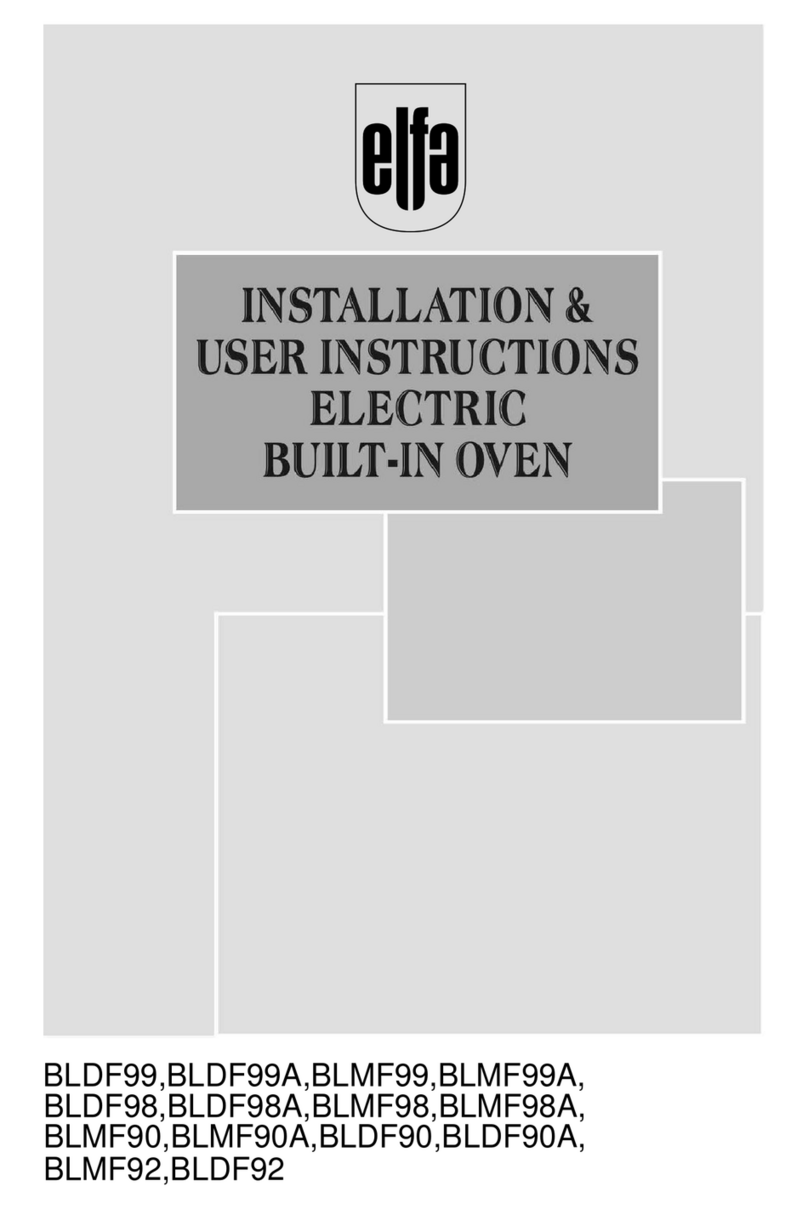
Elfa
Elfa BLDF99 Installation & user's instructions
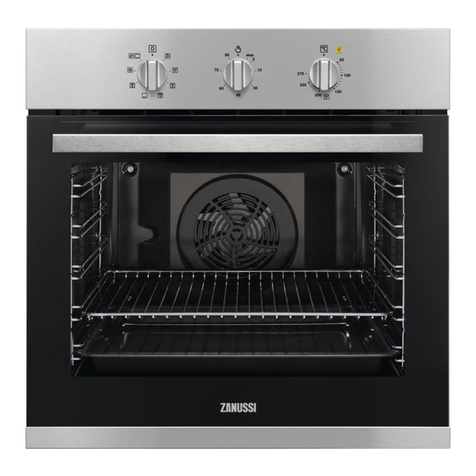
Zanussi
Zanussi ZOB22801XU user manual

Whirlpool
Whirlpool AGS 646/WP installation, user and maintenance instructions
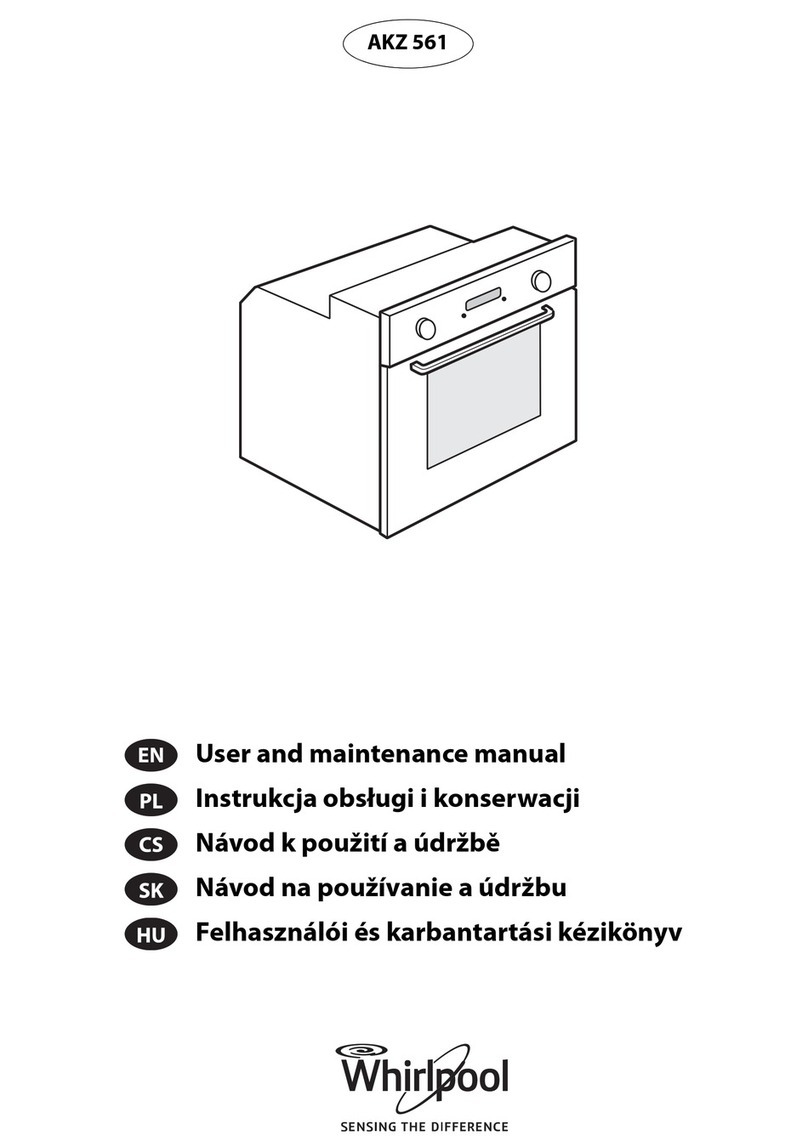
Whirlpool
Whirlpool AKZ 561 User and maintenance manual
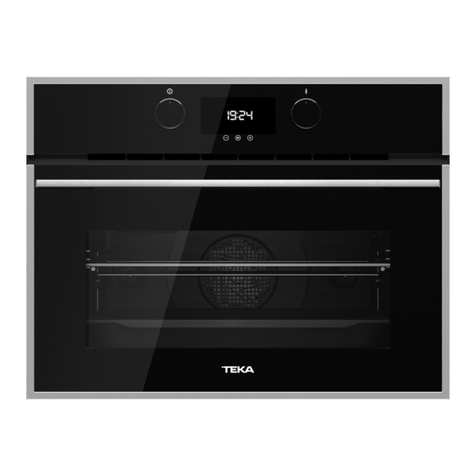
Teka
Teka HLC 840 user guide
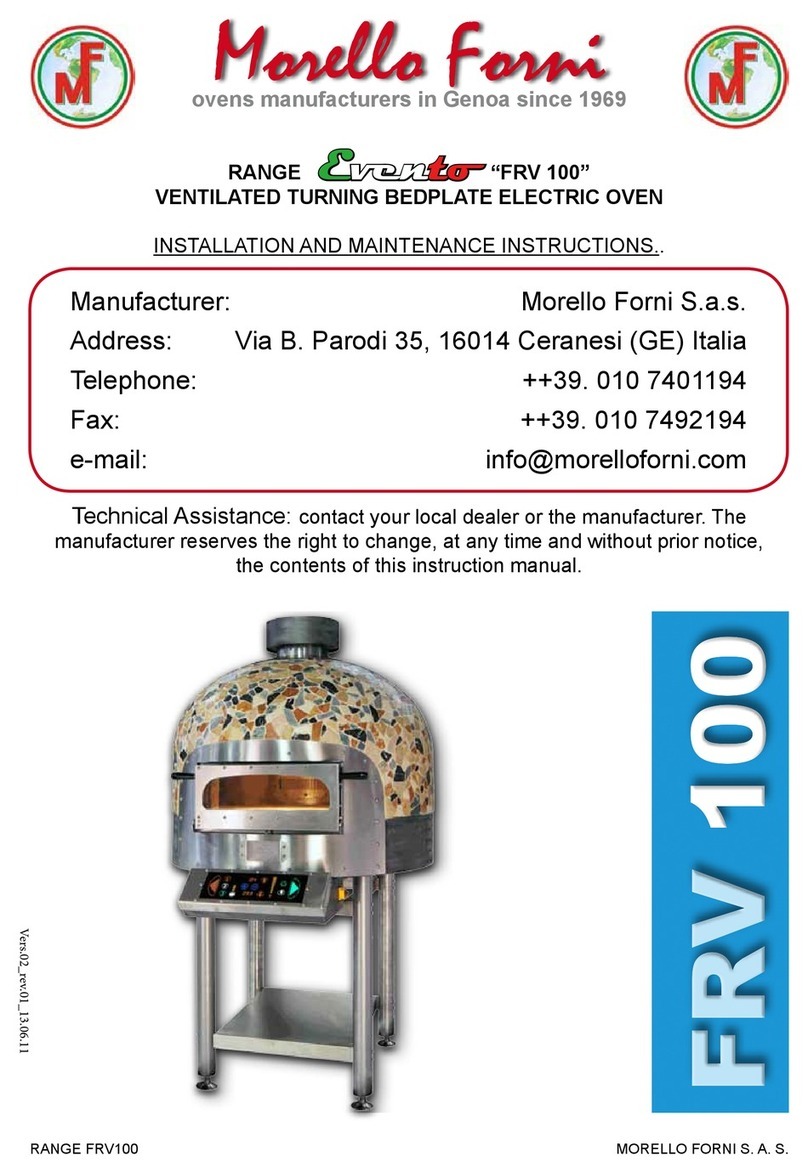
Morello Forni
Morello Forni Evento FRV 100 Installation and maintenance instructions
